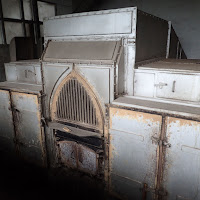 Today, we visited the Halpewatte Tea Factory. Very interesting!!!
Today, we visited the Halpewatte Tea Factory. Very interesting!!!The Halpewatte Tea Factory was built by the British in 1940. During our tour, we learned that all types of tea come from the same evergreen shrub/tree, Camellia sinensis. Which is NOT the same plant that gives us tea tree oil, Melaleuca alternifolia.
In plantations, tea plants are usually about waist high for easy harvesting. They're productive from 4 years of age up to 30 years. But if left uncut, they can grow to 4 meters tall and live for hundreds of years. Who knew?!
 Harvesting is done about every two weeks. Each time, some new leaves are plucked by hand from each plant.
Harvesting is done about every two weeks. Each time, some new leaves are plucked by hand from each plant.There are 6 steps to make black tea: air dry to wither the leaves, roll the leaves to crush the cells, ferment/oxidize, heat dry, sort/grade, and pack. To make green tea, you skip the fermentation. To make white tea, you only use the tiny new shoots and air dry them.
 Orange pekoe tea is just a term for medium black tea. Chai, Earl Grey, and others are made by adding spices/other ingredients. During our tea tasting, we learned that the darker tea has more caffeine, so is best for breakfast. Light tea has less caffeine so is best for evening.
Orange pekoe tea is just a term for medium black tea. Chai, Earl Grey, and others are made by adding spices/other ingredients. During our tea tasting, we learned that the darker tea has more caffeine, so is best for breakfast. Light tea has less caffeine so is best for evening. Pictures
1- This is one of the tea pluckers who worked at the Octagon's small tea garden. She had her bag tied to her waist. Most pluckers have a strap over their head/forehead to hold their bag. It looks like it can get heavy.
2- This is the Demodara tea factory. Many of the tea factories look like this.
 3- This is the air drying area. It has lots of nice windows. Each section/drying bed is well labelled. The amount of time this step takes depends on the humidity in the air.
3- This is the air drying area. It has lots of nice windows. Each section/drying bed is well labelled. The amount of time this step takes depends on the humidity in the air.4-This set of machines rolls the leaves.
5- The leaves are piled about 3 inches deep for fermentation. Our guide stuck his hand into the piles and pulled out tea for us to touch and smell. It was warm and mildly tea tangy.
6- One of the furnaces used to burn wood to heat dry the tea.
7- Amazing new technology! Infrared light is used to separate the black (lower quality) and brown tea (higher quality).
 8-I'm not sure what this step is. But it shows that a lot of the work is still manual. And all the employees there wore tidy green uniforms. Tho most wore either flip flops or no shoes at all. Like many Sri Lankans.
8-I'm not sure what this step is. But it shows that a lot of the work is still manual. And all the employees there wore tidy green uniforms. Tho most wore either flip flops or no shoes at all. Like many Sri Lankans.9- The bags of processed tea are ready for shipping to auctions. At the auctions, buyers get to smell and taste tea from each bag/group of bags. This lets them select the tea that has the characteristics that they are looking for.
PS - It was pretty amazing that we got to walk so close to all of these machines! And we got to touch product as it was made.





No comments:
Post a Comment